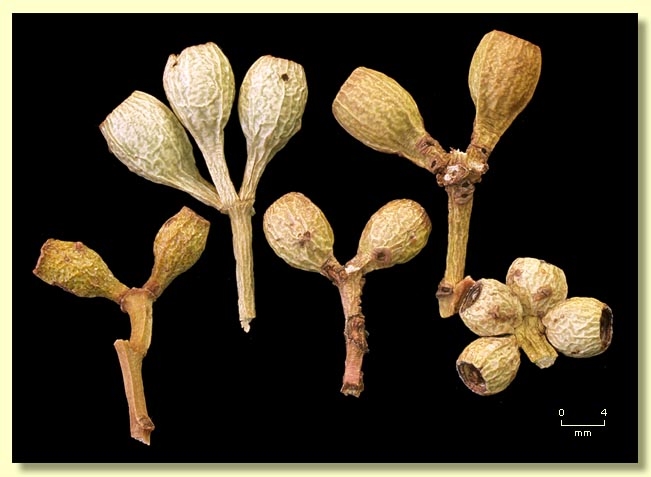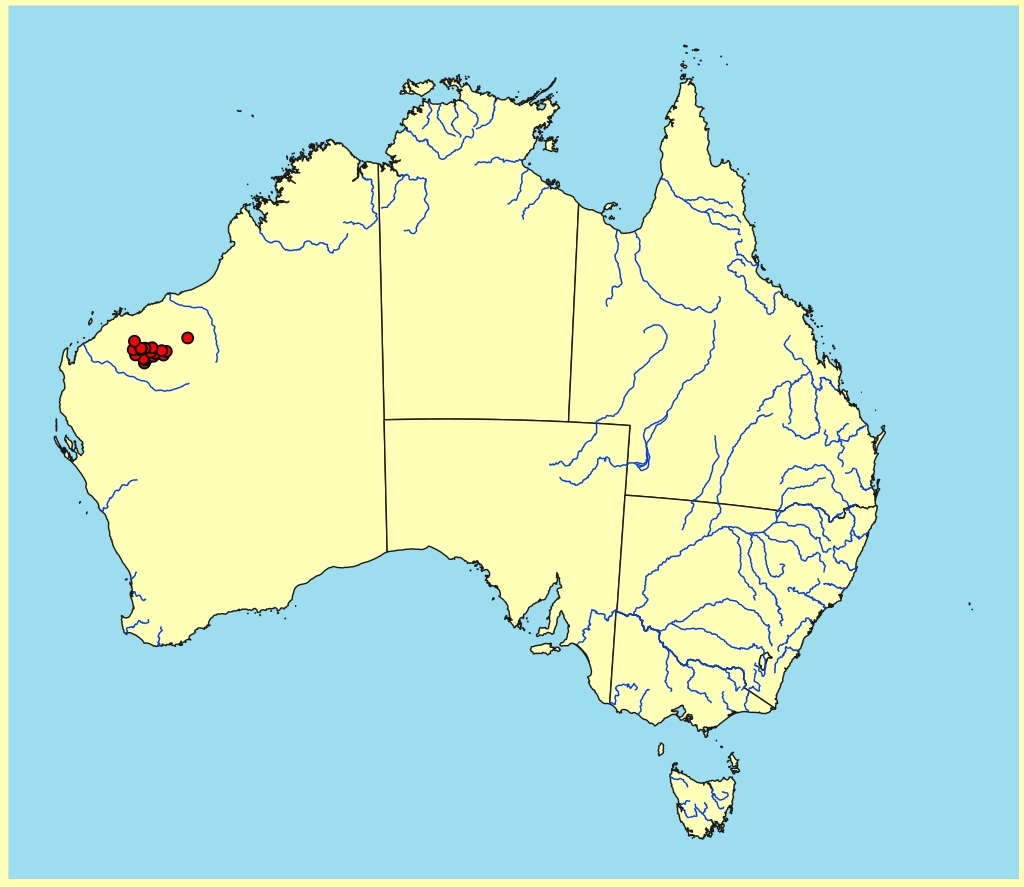Eucalyptus | Symphyomyrtus | Adnataria | Apicales | Buxeales | Amissae
Euclid - Online edition
Eucalyptus aridimontana
Eucalyptus aridimontana D.Nicolle & M.E.French, Nuytsia 22(1) 21-23 (2012).
T: Western Australia: summit of Mount Nameless between Tom Price town and mine, 4 June 2002, A.V.Slee 4409 and J. R.Connors ; holotype PERTH; isotypes AD CANB NSW.
Mallee to 5 m tall. Forming a lignotuber.
Bark smooth throughout or rough for up to half the trunk, finely fibrous persistent box-type, grey-brown, smooth bark pale grey to brownish and bronze or orange-pink.
Branchlets lacking oil glands in the pith; usually not glaucous but wax noted on a specimen from Bold Cliff area.
Juvenile growth (coppice or field seedlings to 50 cm): not seen.
Adult leaves alternate, petioles 0.6–2.2 cm long; blade lanceolate, (5)7–14(17) cm long, 0.7–2(3.2) cm wide, base tapering to petiole, margin entire, apex pointed, concolorous, dull but when fully formed glossy, light green to blue-green, side-veins at an acute or wider angle to midrib, reticulation dense, intramarginal vein remote, oil glands conspicuous, intersectional.
Inflorescence terminal compound, but occasionally single umbels in upper leaf axils also, peduncles thickened 0.6–1.6 cm long, buds 7, 9 and 11 per umbel, pedicels thickened angular 0–0.4 cm long. Mature buds obovoid, 0.5–0.6 cm long, 0.3–0.4 cm wide, scar present (outer operculum lost early in bud development), operculum broadly conical to rounded, stamens inflexed, the outer filaments without anthers (staminodes), inner filaments fertile, anthers more or less cuboid, adnate, sub-dorsifixed, dehiscing by sub-terminal pores, style long and straight, stigma blunt, locules 4 or 5, the placentae each with 4 vertical rows of ovules. Flowers creamy white.
Fruit pedicellate or rarely sessile (pedicels 0–0.5 cm long), barrel-shaped to cylindrical, 0.4–0.9 cm long, 0.4–0.6 cm wide, disc descending, valves 4 or 5, enclosed or just below rim level, rim thickened.
Seeds brown, 1–2 mm long, ovoid to flattened-ovoid, dorsal surface shallowly reticulate, hilum ventral.
Cultivated seedlings (measured at node 10): cotyledons reniform; stems square in cross-section; leaves always petiolate, opposite for ca 5 or 6 nodes, then alternate, ovate to broadly lanceolate, 6.5–9.5 cm long, 1.7–2.6 cm wide, dull, green to weakly grey-green.
Flowering time not recorded.
A low mallee endemic to Western Australia, restricted to the Pilbara region where found in hummock grass and open scrubland high in the landscape on summits, steep slopes and screes, growing in skeletal red soil over ironstone. Partly rough barked or entirely smooth barked and with a crown of dull leaves becoming glossy green at maturity, and barrel-shaped fruit on thickened angular pedicels.
In the classification of Brooker (2000) the more recently published Eucalyptus aridimontana would belong in Eucalyptus subgenus Symphyomyrtus section Adnataria because the buds have two opercula, ovules are in four rows, seeds are flattened-ovoid, cotyledons are reniform, and anthers are rigid on the staminal filaments. Within section Adnataria, E. aridimontana is part of a subgroup, series Buxeales(the boxes), further distinguished by being partially rough-barked, having terminal inflorescences and buds that lose the outer operculum early. Most species in series Buxeales are found in south-eastern Australia, with only six occurring in Western Australia, viz. E. cuprea, E. absita, E. normantonensis, E. lucasii, E. aridimontana and E. rowleyi.
All six western species have inflexed stamens the outermost of which lack anthers (staminodes), features separating them to some extent from the eastern species. Both E. absita and E. cuprea occur further south in better watered areas. E. normantonensis is found north and east of the distribution of E. aridimontana, and has more extensive rough bark, chocolate brown smooth bark and smaller buds and fruit.
Eucalyptus aridimontana was split from E. lucasii, along with E. rowleyi, by Nicolle & French (2012) thus: E. lucasii fully formed adult leaves always dull bluish green, fruit with slender angular pedicels the angles not extending to body of fruit; E. aridimontana fully formed adult leaves ultimately glossy, green, fruit barrel-shaped with two angles extending from base of fruit down the thickened pedicel; E. rowleyi ultimately with glossy green broad adult leaves and more or less cylindrical to barrel-shaped or weakly urceolate fruit on thickened angular pedicels the angles extending onto the fruit. E. lucasii and E. rowleyi both occur on similar low hard flood-out country whilst E. aridimontana is restricted to mountaintops and ridges on ironstone at altitudes greater than ca 900 m.
Eucalyptus aridimontana: from the Latin aridus meaning dry and montanus referring to the elevated habitat.







